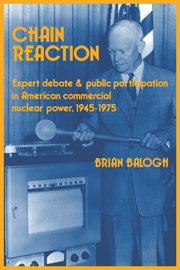 Chain Reaction
Chain Reaction Book contents
- Frontmatter
- Contents
- Acknowledgments
- List of abbreviations
- 1 From fission to fusion: professionalization and politics in twentieth-century America
- 2 The promise of the proministrative state: nuclear experts and national politics, 1945–1947
- 3 Forging an iron triangle: the politics of verisimilitude
- 4 Triangulating demand: the Atomic Energy Commission's first decade of commercialization
- 5 The centrifugal push of expertise: reactor safety, 1947–1960
- 6 The magnetic pull of professional disciplines, issue networks, and local government
- 7 Nuclear experts on top, not on tap: mainstreaming expertise, 1957–1970
- 8 Nuclear experts everywhere: the challenge to nuclear power, 1960–1975
- 9 Conclusion: harnessing political chain reactions
- Index
3 - Forging an iron triangle: the politics of verisimilitude
Published online by Cambridge University Press: 07 May 2010
- Frontmatter
- Contents
- Acknowledgments
- List of abbreviations
- 1 From fission to fusion: professionalization and politics in twentieth-century America
- 2 The promise of the proministrative state: nuclear experts and national politics, 1945–1947
- 3 Forging an iron triangle: the politics of verisimilitude
- 4 Triangulating demand: the Atomic Energy Commission's first decade of commercialization
- 5 The centrifugal push of expertise: reactor safety, 1947–1960
- 6 The magnetic pull of professional disciplines, issue networks, and local government
- 7 Nuclear experts on top, not on tap: mainstreaming expertise, 1957–1970
- 8 Nuclear experts everywhere: the challenge to nuclear power, 1960–1975
- 9 Conclusion: harnessing political chain reactions
- Index
Summary
By setting up a civilian agency to administer America's atomic program and the Joint Committee on Atomic Energy to oversee it, the Atomic Energy Act gave the look of regularized politics to what had been a highly exceptional arrangement. Several factors assured that regularization as it was understood before World War II was skin-deep at best. The premium on military priorities and corollary restrictions on access to information that the national security state placed on the program ensured that its development would not follow prewar patterns. Robert Oppenheimer and his colleagues on the General Advisory Committee (GAC) summed up the AEC's priorities best, informing the president in June 1952 that the GAC could not say where, when, and under what circumstances civilian power would be generated because the bulk of the AEC's work had involved military demands and the production of fissionable materials.
Two additional factors distinguished the politics of commercial nuclear power from politics as usual. The first was the degree to which atomic power was government-initiated. To the extent that interest groups were involved with the issue, only the organized scientists contributed very much to the shape of the program. Government-funded research had made atomic power an issue. For the time being, it would take government initiative to develop it. It was a combination of scientists and administrators, working almost exclusively within the Atomic Energy Commission, that initially kept hopes alive for economically feasible commercial nuclear power, even though these advocates were often the first to admit that this would not occur overnight.
- Type
- Chapter
- Information
- Chain ReactionExpert Debate and Public Participation in American Commercial Nuclear Power 1945–1975, pp. 60 - 94Publisher: Cambridge University PressPrint publication year: 1991


